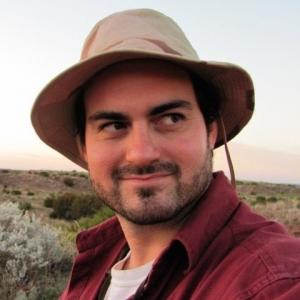I'm a big kid interested in old stuff. My mission is to infect others with wonder for the past. I geek out on human evolution, prehistoric archaeology and ancient technology. I love broken old rocks, especially those which tell a story about human ingenuity
My research is aimed at better understanding the earliest people to settle new frontiers in southern Asia. Who were the first South Asians and when did they settle the Indian subcontinent? My longtime research in western India has sought answers to these questions. As a Fulbright scholar in India, I worked with new and decades-old collections from universities and museums. I also led a field program that identified the most productive Ice Age fossil locality in western India. My ongoing research is focused on: 1) better understanding the timing and production of transitional lithic technology in western India, and 2) continuing efforts to recover human fossil remains from Gopnath, a key site with unique bone preservation in an area with clear signs of human occupation.
As the lab director for the Houston Archeological Society (HAS) I serve as the custodian of collections that include a diverse assortment of items (e.g., lithic, glass, ceramic, fauna, field notes and documents) from the historic and prehistoric sites of southeastern Texas. I recently initiated a project to revitalize the HAS collections and their facilities within the Rice University Archaeology Lab. This work has involved general improvements to furnishings, collections shelving, storage and labeling. Ongoing inventory of HAS holdings such as the Bill McClure comparative fauna collection are being accomplished with the end goal of providing online access to these and similar resources.
As an anthropologist interested in human origins, I spend a lot of time thinking about how our ancestors learned from each other. Teaching in the Stone Age was very serious business with life and death in the balance. In my courses, students may actually learn a few useful survival skills, but they also take away transformative experiences. I believe experiential learning is critical to education. I’ve received teaching grants from Rice University to support interactive lessons in experimental archaeology and paleontology.
In my paleontology courses, students unearth fossil remains untouched for millions of years. Students in geoarchaeology decipher layered earth history in the field. Young archaeological scientists use a fabricated crossbow for experiments crash-testing arrowheads. Finally students in my paleo-technology course learn the mysterious craft of stone knife making, spear throwing and friction fire making.
My main goal as an instructor is to inspire curiosity and wonder in the known and unknown. Natural history and anthropology are wondrous subjects. They tell us about our place in nature, but are dynamic fields with limitless possibilities for new discoveries. Like any scientific endeavor the excitement is in the mystery: what we don’t know, but feel we must. An appreciation of these qualities is critical for the student of archaeology or paleontology. Students who first learn the appeal of the past relish the obscure dates, esoteric terminology and other seemingly trivial knowledge.
I collaborate often with experts within and outside of Rice to provide varied perspectives. I’ve worked closely with the Houston Museum of Natural Science for several years on visiting exhibits like “Scenes From The Stone Age: The Cave Paintings of Lascaux” and events such as International Archaeology Day. I have also served as an adult school and Boy Scout instructor at the Houston Museum of Natural Science for several years and often leverage my connections there to enhance all my courses.
Most recently my paleontology students we’re able to participate in field and lab work with the Whiteside Museum of Natural History and Houston Museum of Natural Science. My ongoing role as a supervisor for the Katy Mammoth Project has generated additional learning opportunities for students in the field and lab.
COURSES
Paleo-Technology (384); Geoarchaeology (330); Paleontology (166); Asian Prehistory (374)
SELECTED PUBLICATIONS
2015 Costa, A. G. (accepted) New observations on animal bones and Palaeolithic tools from Tejpur, Northern Gujarat. Heritage: Journal of Multidisciplinary Studies in Archaeology
2015 Costa, A. G. (in press) First Late Pleistocene fossil fauna from the dry coastal zone of tropical southwestern Asia: Implications for early human dispersals along inundated coastal corridors. Quaternary International
2015 Vrba, E., F. Bibi, and A. G. Costa, First Asian record of a late Pleistocene reduncine (artiodactyla, bovidae, reduncini), Sivacobus sankaliai, gen. et sp. nov. from Gopnath (Miliolite Formation) Gujarat, India and a revision of the Siwalik genus Sivacobus, Pilgrim, 1939. Journal of Vertebrate Paleontology, 35(4), e943399
2013 Costa, A.G.. Were there Indian Neanderthals? On the probable affinities of the South Asian Middle to Late Pleistocene paleodeme. Indian Journal of Physical Anthropology and Human Genetics 32(1): 13-18.
2012 Costa, A.G., Were there stone-tipped armatures in the South Asian Middle Paleolithic? Quaternary International, DOI: 10.1016/j.quaint.2011.01.044, 269, 22-30.
2011 Costa, A.G., Ajithprasad, P. and B. Sharma, 2011. Tracking Early Humans in coastal western India: the Gujarat Palaeoanthropology Project. Antiquity 85 (327).
2010 Costa, A.G. 2010. A geometric morphometric assessment of plan shape in bone and stone Acheulean bifaces from the Middle Pleistocene site of Castel di Guido, Latium, Italy. In Lycett, S.J. & Chauhan, P.R. (Eds.) New Perspectives on Old Stones: Analytical Approaches to Palaeolithic Technologies. Springer Press, New York. pp.23-41.

